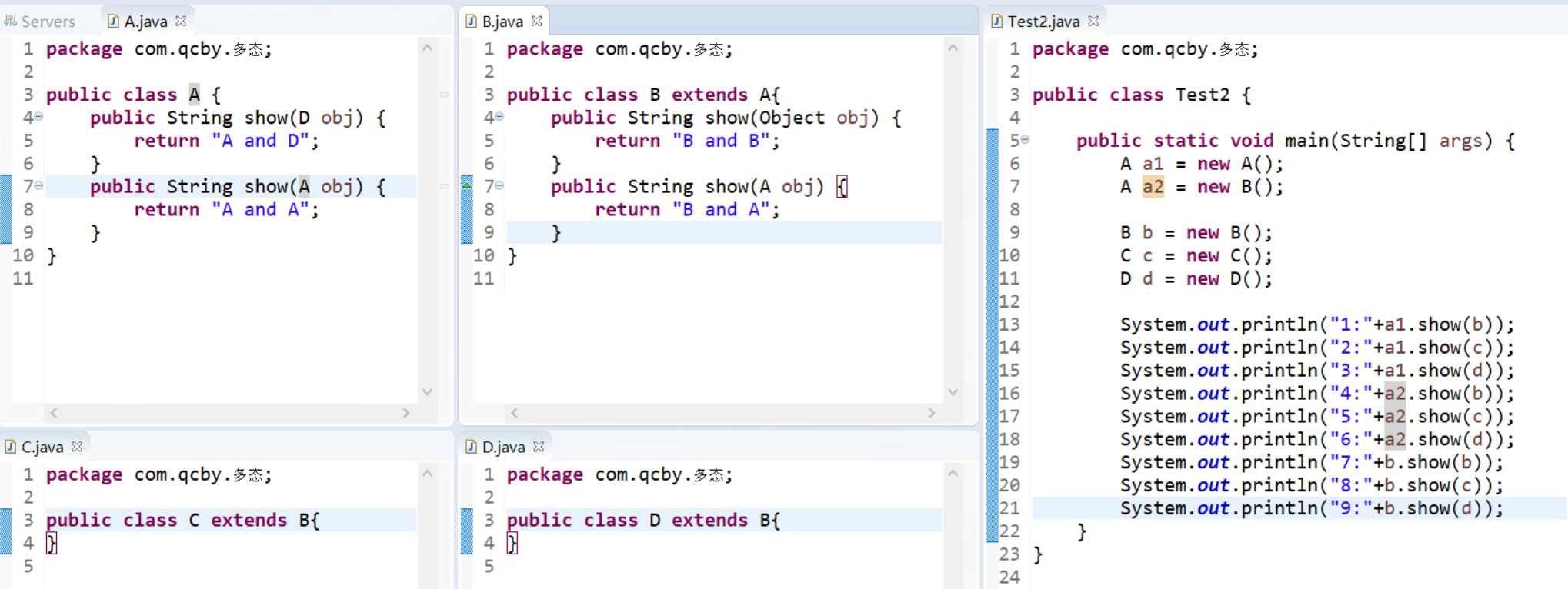政府网站专题栏目建设方案新乡网站推广

1:A and A
2:A and A
3: A and D
4: B and A
5: B and A
6:A and D
7:B and A
8: B and A
9:A and D
package 第四章对象和类;public class ForthThir {//多态:父类的引用指向子类的对象,只能调父类的方法和子类重写的方法,不能调子类独有的方法;子类则可以调父类独有的方法//条件:必须继承关系、必须要重写,父类的引用指向子类对象/** public class Parent{* public void eat(){System.out.println("Parent"); }* }* * public class Child1 extends Parent{* public void eat(){System.out.println("Child1");}* }* * public class Child2 extends Parent{* public void eat(){System.out.println("Child2");}* }* * public class Grand1 extends Child1{* public void eat(){System.out.println("Grand1");}* }* * * public class Test{* public static void main(String[] args){* Parent xx=new Parent();* xx.eat();* xx=new Child1();* xx.eat();//执行Child1里的方法* * * aa(new Parent());* aa(new Child1());* }* public static void aa(Parent xx){* xx.eat();* }///强制类型转换 大碗不能自动转成小碗* Parent xx =new Grand1();* Child1 yy=(Child1)xx;* Child2 yy=(Child2)xx;//运行报错,xx内核为Grand类型数据* * 引用类型到底能不能转,做判断:* instanceof 判断xx是否位Child2类型的对象,或者Child2子孙后代的对象* if(xx instanceof Child2){* Child2 yy=(Child2)xx;* * }* * * int a=32;* short b=(short)a;* * int[] arr={100,2457,120,22};* for(int i=0;i<arr.length;i++){* char j =(char)arr[i];* System.out.println(j);* }* }*///基本数据类型/** int a=10;* Integer b=10;* * int Integer String * * int->Integer new Integer():* int a=10;* Integer a_p=new Integer(a);* * Integer->int intValue()* Integer a_p=new Integer(4);* int a=a_p.intValue();* * Integer->String toString();* Integer a_p=new Integer(4);* * * * String->/integer:new Integer()* String a="888";* Integer b=new Integer(a)* * int->String String.valueOf()* int a=10;* String b=String.valueOf(a);* * String->int Integer.parseInt()* String a="999";* int b=Integer.parseInt(a);* *///装箱:基本类型->包装类/** int a=10;* Integer i=Integer.valueOf(a);* 或Integer j=new Integer(a);*///拆箱 包装类->基本类型/** Integer k=new Integer(10);* int b=k.intValue();*///自动装箱 直接把一个int类型的数据直接赋值到Integer(java 5之后)/** int c=20;* Integer p_auto=a;* 或 Integer m=100;*///自动拆箱(把一个包装类型的数据变成基本类型数据)/** Integer l=new Integer(10);* int d_auto=l;*///128陷阱/** Integer num1=100;/=150 调的是valueOf方法,避免频繁创建 * Integer num2=100;/=150* System.out.println(num1==num2);true/false 超过128就是false* Integer num3=new Integer(100);* Integer num4=new Integer(100);* System.out.println(num3==num4);false* * */}
package com.qc.Object;public class Test {public static void main(String[] args) {Object aa=new Object();aa.equals(obj);aa.hashCode();//equals()比较内存地址指向是否相同//getClass()获取类的信息 反射邻域//hashCode()获取散列码 根据地址生成//哈希表:数组+链表结构String a="ok";String b=new String("ok");Person x1=new Person();Person x2=new Person();System.out.println(x1.hashCode());//x1,x2的hashCode不同;a,b的hashCode相同,因为String重写了方法//(Objects里)equals判断是否为同一个对象;hashCode判断是否是同一类 大部分类在重写equals方法时会重写hashCode方法//如果两个对象相同(equals方法返回true),那么他们的hashCode值一定相同//如果两个对象不同(equals方法返回false),他们的hashCode值可能相同 可能不同//如果两个对象hashCode值相同(存在哈希冲突),他们可能相同可能不同(equals方法可能返回false,可能返回true)//如果两个对象hashCode值不同,那么他们两个肯定不同(equals方法返回false)//面试题1:两个不同的对象,hashCode有没有可能相同? 可能,有极小概率//面试题2:重写equals方法为什么要重写hashCode方法?一定要重写吗?//跟hashmap 如果不使用hashmap则不需要重写hashCode;equals和hashCode在hashmap里是配合使用的//hashmap比较key值的时候使用equals方法比较是否重复,存入values时要使用hashCode确定位置//访问权限修饰符(修饰变量/方法) 当前类 同包 子类 跨包 其他包//public ✔ ✔ ✔ ✔//protected ✔ ✔ ✔ ✖//默认 不写 ✔ ✔ ✖ ✖//private ✖ ✖ ✖ ✖//wait() 线程进入等待状态 让出CPU和锁//notify() 唤醒等待的线程//toString() 输出对象的类型和内存地址//hashCode()}
}
"128陷阱"是Java中关于整数缓存机制的一个经典问题,主要涉及Integer类的缓存行为和自动装箱/拆箱机制。
-
Integer缓存机制:
-
Java对
-128到127之间的Integer对象进行了缓存 -
当使用自动装箱或
Integer.valueOf()方法时,会优先从缓存中获取对象
-
底层原理
-
IntegerCache类:
-
Java在
Integer类内部维护了一个静态的IntegerCache类 -
默认缓存了-128到127之间的Integer对象
-
-
自动装箱行为:
-
当使用
Integer i = 100这样的语法时,实际调用的是Integer.valueOf(100) -
valueOf()方法会先检查是否在缓存范围内
-
目的:
-
减少对象创建:对于常用的小整数(-128~127),通过缓存复用对象,避免重复创建
